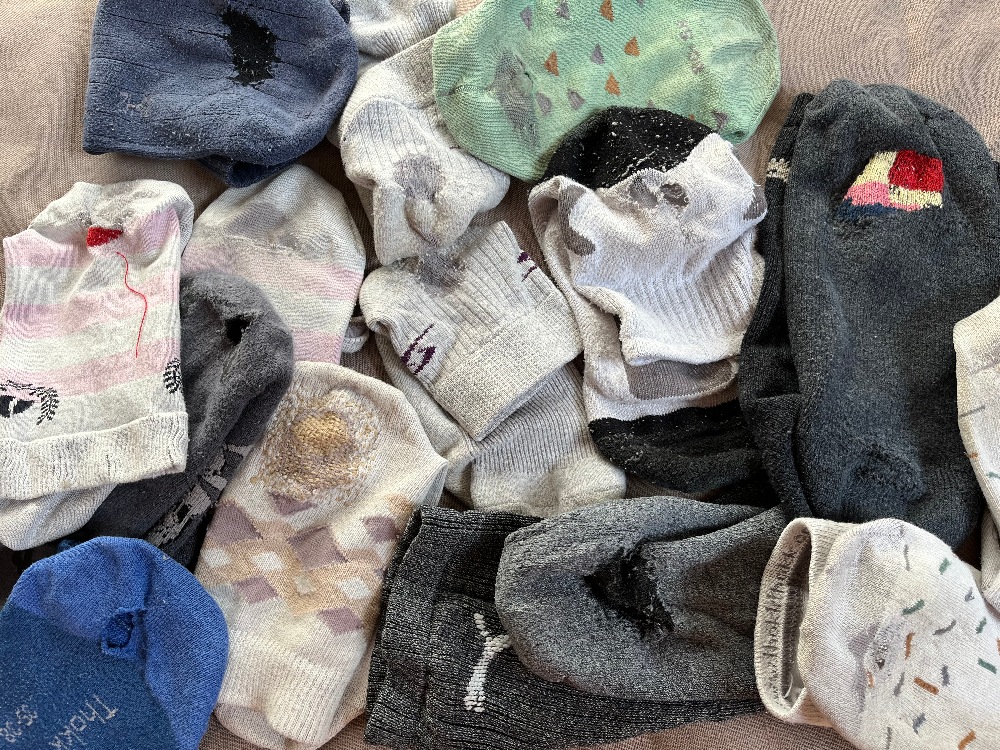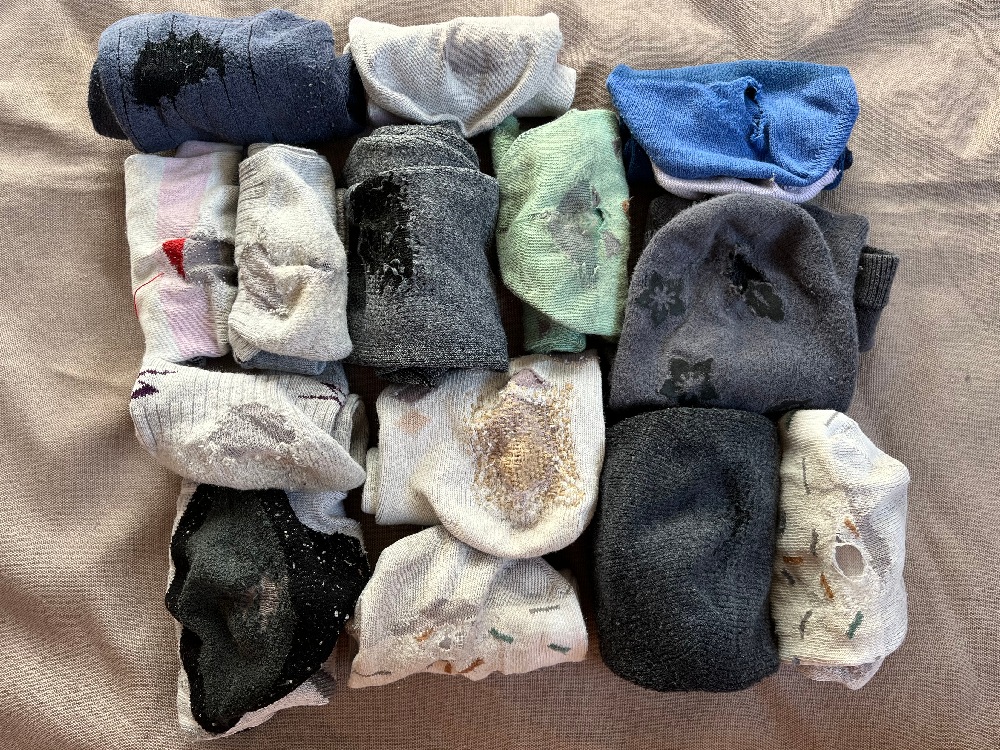Wieso weshalb warum stopfen – ein Blick zurück
Es geht weiter mit meiner sehr losen Serie zu „Mein stopfendes Leben“ (Arbeitstitel). Den Auftakt machte der Post Stopfen, (m)ein Einsteig. Nun kommt etwas Hintergrundgedöns und ein Blick zurück.
Ein Zeitstrahl: Wie ging es los?
Tatsächlich habe ich in früheren Posts schon mal geschrieben wieso weshalb warum, lange bevor ich wusste, dass ich diese Reihe schreiben werde. Der erste Post auf dem Blog zum Thema Stopfen war Das Sockengeschwisterpaar und prosaisch angehaucht (…oder zumindest versucht). Es fängt damit an, dass geliebte Socken von mir ein Loch an der Ferse hatte und ich entsprechend traurig war. Ab hier zitiere ich aus dem Post:
Eines Tages, die Besitzerin [ich] war in einem Nähcafé, hörte sie das erste Mal von einer Tätigkeit namens „stopfen“. Es hieß, damit könne man Löcher schließen. Aber nicht, indem man etwa die Ränder zusammenzieht und vernäht. Nein – dort, wo ein Loch ist, sollte neues Gewebe entstehen. Die Besitzerin war verwirrt und konnte sich solch eine Tätigkeit nicht vorstellen. Neues Gewebe erstellen, wo eigentlich nichts ist?
Wie die Geschichte dann genau weiterging, ist nicht mehr ganz bekannt. Was bekannt ist, ist dass die Besitzerin einem Instagram-Account folgte, das sich viel mit dem Reparieren und Erhalten von Kleidungsstücken beschäftigte und so lernte sie das Wort „mending“ kennen. Faszinierend, was alles möglich war.
Und irgendwann verstand die Sockenpaarbesitzerin: Die Technik, die sie auf dem Instagram-Account sah, nannte sich im Deutschen stopfen.
Aber:
- Wie funktioniert überhaupt die Technik des Stopfens?
- Welche Materialien brauche ich?
- Wer kann mir erklären wie ich stopfe?

Während es zu anderen Handarbeiten wie Stricken oder Häkeln Videoanleitungen en masse gibt, war das gar nicht so einfach beim Stopfen. Vidoeanleitungen habe ich damals kaum gefunden (wer weiß, mit welchen Keywords ich gesucht habe; wahrscheinlich habe ich nur das deutsche Keyword benutzt und das zeigte mir eher den Stopfen als das Stopfen) und wenn, dann waren sie nicht zufriedenstellend. Auch in der Suchmaschine meines Vertrauens kam nicht viel rum. Am Ende habe ich Bücher gefunden zu dem Thema und mir dann eines bestellt: Geschickt geflickt von Erin Lewis-Fitzgerald [1]. Auch wenn ich es seither vor allem nur durchblättere und nicht so viel damit arbeite (weil ich eh nur zwei Techniken benutze), war es für mich ein Anker. An der Hand geführt werden von jemandem, die sich schon länger mit dem Thema beschäftigt und Ahnung hat.
Mit diesem kleinen Sammelsurium an Informationen bin ich losgelaufen und die ersten Socken gestopft. Und habe dann weitergemacht. Beim Stopfen komme ich ganz krass in so einen Sog und will vorwärts kommen. Bei keiner anderen Handarbeit habe ich das bisher erlebt. Aber zwischen zwei Stopfarbeiten liegen wiederum durchaus mal mehrere Monate.
Faszination an Friemelarbeit?
Und nun bitte die Frage beantworten: Was fasziniert mich so an dieser Friemelarbeit (die es ist)??
Diese Frage beantwortet das folgende Zitat aus meinem anderen Blogpost Zurück! mit einem Reparaturwerk
Ich finde die Reparaturkultur in jeder Hinsicht total faszinierend und auch gewissermaßen heilsam. Nicht nur für das Stück, das repariert wird, sondern auch so mein eigenes Wohlbefinden. Es ist wie das Gefühl, selbst etwas kreiert oder erschaffen zu haben, mit seinen eigenen Händen und Füßen.
Aber on top ist es dieses Gefühl, etwas wieder heile gemacht zu haben. Einen Schmerzpunkt schließen.
So kommt das Thema Selbstwirksamkeit wieder ins Spiel. Oft sind es nicht mal geliebte Kleidungsstücke von mir, die gestopft/repariert werden. Es ist wirklich diese Tatsache, etwas reparieren zu können und wieder nutzbar zu machen, das mir ein tolles Gefühl gibt. Eine Fähigkeit, eine Handfertigkeit zu erlernen und dann tatsächlich anzuwenden. Am beeindruckendsten ist es, diese Fähigkeit durch Vorher-Nachher-Fotos sichtbar zu machen. Das ist auch Tipp 3 aus dem oben erwähnten Buch. Auch das Thema Nachhaltigkeit spielt eine Rolle, weil ich es für mich nicht okay finde, wenn ich ein Kleidungsstück wegen eines Lochs entsorgen würde ohne probiert zu haben eine Lösung zu finden. Und diese beiden Punkte führen mehr oder weniger zu dem Grund, warum ich das nicht nur für mich, sondern auch für dich verblogge: sharing is caring. Teilen von: Gefühl der Selbstwirksamkeit; und auch das Wissen, kaputte Kleidungsstücke wieder zu reparieren.
Und wie ging es weiter?
Dank Instagrams Algorithmus hat es ausgereicht, einen Account zum Thema zu finden. Danach hat sich mir wie von selbst eine ganze Welt dahinter eröffnet und mir wurden viele Posts und entsprechend Accounts angespült. Andere Medien bedienen das Thema zwar auch, aber meiner Meinung nach lange nicht so gut wie Instagram als Foto-Plattform, Instagram ist in der Hinsicht aktuell mein Lieblingsmedium zu diesem Thema.
Zum Schluss (ich schließe den Post nicht ohne ab) zwei Instagram-Accounts als Empfehlung zum Start:
- Marlen von @milli_and_the_bee, oder hier auf ihrer Webseite.
- Ekaterina von @ekaterinahaak, oder hier auf ihrer Webseite.
Vom jeweiligen Instagram-Account aus kannst du dich gut weiterklicken, wenn du mehr Interesse hast 🙂
Und noch das erwähnte Buch:
[1] „Geschickt geflickt. Lieblingskleidung ausbessern satt wegwerfen.“ von Erin Lewis-Fitgerald im Verlag stiebner, ISBN: 978-3-8307-2104-8
-----
Emoji Reaktion


Ich finde es super, wenn man Dinge repariert, anstatt sie auszutauschen! Sockenstopfen ist echt eine Friemelarbeit. Schon oft probiert, manchmal mit Erfolg und manchmal habe ich einfach aufgegeben. 😉
Spätestens dann, wenn die Socke anschließend nicht mehr gut gepasst hat… Ich habe vielleicht auch nicht das Beste Händchen dafür… 😉
Ich glaube ich habe auch noch ein paar unvollendete Socken irgendwo rumliegen 😀 Und das ist natürlich sehr ärgerlich, wenn die Socke nicht mehr gut passt. Dann doch wieder lieber ein Loch reinmachen 😛